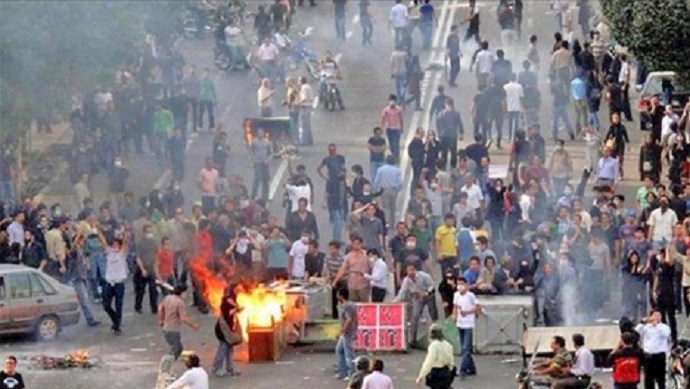Analysis by PMOI/MEK
Iran, November 7, 2020—During November 2019 nationwide uprising, Iran witnessed the largest anti-regime protests since the 1979 revolution. The protests erupted on November 15, 2019, when regime officials issued a three-fold gasoline price hike and sparked outrage across the country, spreading to more than 190 cities.
Iranian regime Supreme Leader Ali Khamenei issued an order to do “whatever it takes” to quell the protesters and the regime’s forces gunned down 1,500 civilians in a few days, according to statistics tallied by the network of Iranian opposition People’s Mojahedin Organization of Iran (PMOI/MEK).
As many regime officials have acknowledged, the November 2019 uprising was organized cluster of protests in which women and youths were among the leading participants. The entire regime and the Revolutionary Guard (IRGC) taking part in cracking down on the protests showed how the regime is lined up against the Iranian people.
A member of the regime’s Majlis (parliament) acknowledged that “more than 500 cities and towns across the country were involved in the unrest following the gasoline price protests.”
Women’s leading role during the protests
Women played an influential role in leading the November 2019 protests. It is worth noting that Iranian women were among the first victims of clerical regime ruling in Iran since the 1979 revolution and therefore their leading role in the protests inspired many of the oppressed.
“Women’s participation in the recent turmoil seems significant. In many places, especially in the outskirts of Tehran, women between 30 and 35 years old played a special role in leading the riots,” according to the Fars news agency, an outlet linked to the IRGC.
“A special mission was defined for women. They played a key role in both attacking the female Basij bases and in motivating the youth. No casualties were reported among them, yet their style of employing women was like the MEK women’s tactics,” according to the IRGC-associated Javan daily.
Many regime officials also acknowledged the fact that the protests were organized. “The rioters were an organized group. They were doing the same thing all over the country,” said IRGC commander Mohammad Hossein Saffar Harandi.
“The role of the MEK in recent events in the country was very bold. In a way that they caused widespread destruction through their management and influence in some cities,” said Mohammad Taghi Shahcheraghi, the IRGC commander in the city of Qom, central Iran.
Seyed Hossein Naghavi Hosseini, former spokesperson of the Majlis Security Commission acknowledged how the protests were formed and led. “Over the past two years, the MEK has been training various groups and circles and leading them in protests,” he said.
Widespread November 2019 protests
Iran’s nationwide November 2019 uprising spread in more than 190 cities and would have continued if not for the regime’s brutal repressive measures.
“On the first day 28 provinces, 100 cities and towns were involved in the protests. When I spoke to some IRGC commanders in various cities they told me that it is like Operation Karbala 4 (referring to a major ground attack carried out by Iran during the 1980s Iran-Iraq war, in which the regime suffered severe casualties). We actually fought for 48 hours,” said deputy IRGC chief Ali Fadavi.
“In the past forty years of the Islamic Revolution, these events were unparalleled in their breadth and dimensions,” said IRGC political deputy Yadollah Javan.
Salar Abnoush, an IRGC Basij commander, described the November 2019 protests as a “full-scale world war.”
Political and social effects of the protests
Deeply concerned of being overthrown, the regime carried out unprecedented crackdown and killings in response to the November 2019 uprising. Many youths, women, and students were among the victims. This had broad social and political impacts and was a turning point in the Iranian people’s struggle for freedom. It caused more anger and hatred among the people towards the regime and turned the November uprising not into a transient event but an ongoing uprising.
Protests erupted yet again in Tehran shortly after Iranian regime authorities acknowledged having shot down a Ukrainian passenger plane on January 8 with the slogan: “1500 people of us were killed in November,” and “Down with Khamenei!”
The continuation of protests across the country during throughout 2020 showed the Iranian people’s determination and burning desire to overthrow the mullahs.
The people also chanted “Down with dictators, be it the Shah or the Supreme Leader,” “No to the mullah and no to the Shah,” “No to the crown and no to the turban (referring to the mullahs),” signaling a rejection of the current and previous dictatorships in Iran. These slogans echoed the Iranian people’s yearning for freedom and democracy despite 41 years of brutal repression, torture, and execution, and showed that they want neither the mullahs and nor the return of the Shah.
Two nationwide protests, in a short period between January 2018 and November 2019, also proved that the regime of the Supreme Leader is in its final phase and is incapable of solving its political, social, and economical crises.
In the meantime, the Iranian people are not questioning whether this regime should go, but are preparing for the next spark and opportunity to overthrow Iran’s tyrants.





